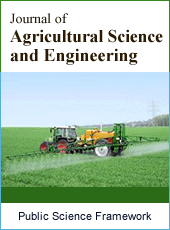Journal of Agricultural Science and Engineering
Articles Information
Journal of Agricultural Science and Engineering, Vol.1, No.3, Aug. 2015, Pub. Date: Jul. 15, 2015
The Role of Information Asymmetry in Monitoring Food Security Programme in ‘Bar A’ Sub Location Kisumu County
Pages: 120-134 Views: 5655 Downloads: 1708
[01]
Samuel Jerry Odindo, Department of Health System Management, Faculty of Community Health and Development, Great Lakes University of Kisumu; Kisumu, Kenya.
[02]
Dan Odhiambo Odindo, Department of Health System Management, Faculty of Community Health and Development, Great Lakes University of Kisumu; Kisumu, Kenya.
[03]
Aaron Mwayi, Department of Health Promotion, Faculty of Community Health and Development, Great Lakes University of Kisumu; Kisumu, Kenya.
This was a longitudinal research that monitored the same households for one seasons and later on display the information to the farmers on a noticeboard as a way of sensitizing them on good farm management practices. The use of a noticeboard is a positioning concept from community health strategy that uses chalkboard as community based health information system to monitor health status in the community. Key findings was analyzed and used to determine the role of the information on the notice board in increasing food production and also to determine farm inputs and activities that are associated with production of food crops in ‘Bar A’ sub location, as a way of eradicating poverty and hunger in the sub location. Census was done for the 640 households. Descriptive statistics was used to determine the frequency of households engaged in different variables grouped as: -, total household member, acreage of arable land and acreage ploughed for maize and beans, and quantity stored for maize, beans and groundnuts. Frequency were run using SPSS and Chi square test to determine the associations of farm input, such as fertilizer application, and activities such as weeding that are associated to production of maize, beans, groundnuts and vegetables. Logistic regression analysis was used to determine the variable which is more associated than the other, if all variables of fertilizers application and weeding are put together.
Monitoring Food Security, Information Asymmetry, Food Production, Participatory Programme Planning, Target Plan, Community Nutrition
[01]
Food and agriculture Organization of the United Nation (2003), Trade reforms and Food Security.
[02]
GOK (2001), Kisumu District Poverty Reduction Strategy Paper, a consultation report for period 2001 to 2004.
[03]
GOK (2008), Kisumu District Development Plan, 2008 to 2012.
[04]
GOK (2001) Report of the sector working group on agricultural and rural development in Kenya.
[05]
GOK (2010), Agricultural Sector Development Strategy 2010 to 2020.
[06]
Kenya National Bureaus of statistics (2008), Food Insecurity Assessment in Kenya based on Kenya Integrated household budget surveys (2005/2006.)
[07]
Kirichu S., (2013), SQUEAL report, OTP program, Kisumu East District, Kisumu county, Kenya.
[08]
Maillot, M., Darmon N. and Drewnowski A (2009), Are the lowest cost healthful food plans culturally and socially acceptable?
[09]
Nzanzu Jeremie., Dan Kaseje, Rose Olayo and Caro Akinyi (2014). Utilization of Community- based Health Information System in Decision making and Health Action in Nyalenda, Kisumu County, Kenya. Universal journal of medical Science.
[10]
United Nation (2010), Food and Agriculture Organization.
[11]
USAID (2012), Infant and young child nutrition project.

ISSN Print: 2381-6821
ISSN Online: 2381-6848
Current Issue:
Vol. 7, Issue 4, December Submit a Manuscript Join Editorial Board Join Reviewer Team
ISSN Online: 2381-6848
Current Issue:
Vol. 7, Issue 4, December Submit a Manuscript Join Editorial Board Join Reviewer Team
| About This Journal |
| All Issues |
| Open Access |
| Indexing |
| Payment Information |
| Author Guidelines |
| Review Process |
| Publication Ethics |
| Editorial Board |
| Peer Reviewers |


